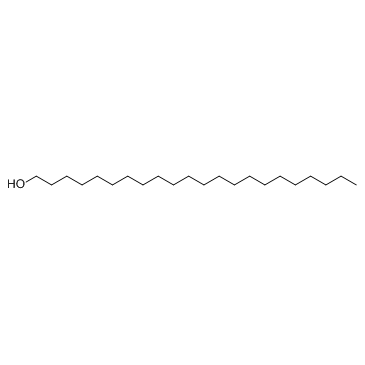Weak first-order tilting transition in monolayers of mono- and bipolar docosanol derivatives.
Xiuli Yue, Bodo Dobner, Ken-ichi Iimura, Teiji Kato, Helmuth Möhwald, Gerald Brezesinski
Index: J. Phys. Chem. B 110(44) , 22237-44, (2006)
Full Text: HTML
Abstract
A systematic analysis of pressure-area isotherms and grazing incidence X-ray diffraction (GIXD) data of 22-methoxydocosan-1-ol (H3C-O-(CH2)22-OH, MDO), docosan-1-ol (H3C-(CH2)21-OH, DO), and docosyl methyl ether (H3C-(CH2)21-O-CH3, DME) monolayers on pure water between 10 and 35 degrees C is presented. All monolayers form fully condensed phases in the investigated temperature region. The GIXD data reveal that the monolayers exhibit the phase sequence -S at lower temperature and -LS at higher temperature. Phase diagrams have been established. Inserting a second hydrophilic group at the opposite end of the molecule (bipolar MDO) shifts the S/LS boundary to higher temperatures. All monolayers exhibit herringbone (HB) packing at lower temperatures. The "kink" in the isotherms observed at lower temperatures is replaced by a very small plateau region at higher temperatures. The entropy changes connected with this weak first-order tilting transition are much smaller compared with the first-order transition from liquid-expanded (LE) to condensed (LC). Additionally, this transition is endothermic in contrast to the LE/LC transition. The reason for the endothermic transition is the weaker positional correlation in the nontilted state compared with the tilted one. The appearance of the weak first-order endothermic transition can be connected with the changed phase sequence. X-ray photoelectron spectroscopy (XPS) measurements provide information about the polar group orientation. Considerations based on GIXD and XPS data as well as adhesion energy of the different terminal end groups lead to the conclusion that the hydroxyl group of the bipolar MDO is attached to the water surface while the methoxy group is in contact with air. The presented results show that the second hydrophilic group influences the monolayer properties in a mild way.
Related Compounds
| Structure | Name/CAS No. | Molecular Formula | Articles |
|---|---|---|---|
 |
1-Docosanol
CAS:661-19-8 |
C22H46O |
|
Translating clinical findings into knowledge in drug safety ...
2011-12-01 [J. Sci. Ind. Res. 65(10) , 808, (2006)] |
|
Surface properties of artificial tear film lipid layers: eff...
2014-07-01 [Invest. Ophthalmol. Vis. Sci. 55(7) , 4448-54, (2014)] |
|
Bioactive constituents in Prunus africana: geographical vari...
2012-11-01 [Phytochemistry 83 , 70-8, (2012)] |
|
Exploration of natural product ingredients as inhibitors of ...
2015-01-01 [Drug Des. Devel. Ther. 9 , 3313-24, (2015)] |
|
Rapid sampling of molecules via skin for diagnostic and fore...
2010-07-01 [Pharm. Res. 27(7) , 1255-63, (2010)] |